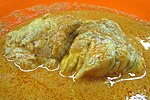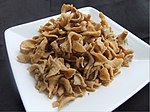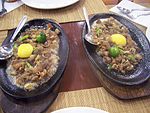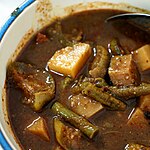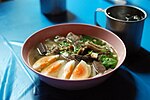Offal
This article needs additional citations for verification. (May 2009) |


Offal (
Some cultures strongly consider offal consumption to be
Depending on the context, offal may refer only to those parts of an
Etymology
This section needs additional citations for verification. (October 2016) |
The word shares its etymology with several Germanic words: West Frisian ôffal, German Abfall (Offall in some Western German dialects and Luxembourgish), afval in Dutch and Afrikaans, avfall in Norwegian and Swedish, and affald in Danish. These Germanic words all mean "garbage/rubbish" or "waste" or—literally—"off-fall", referring to that which has fallen off during butchering. However, these words are not often used to refer to food except for Afrikaans in the agglutination afvalvleis (lit. "off-fall-flesh"), which does indeed mean offal.[3] For instance, the German word for offal is Innereien meaning innards and the Swedish word is inälvsmat literally meaning "inside-food". According to the Oxford English Dictionary, the word entered Middle English from Middle Dutch in the form afval, derived from af (off) and vallen (to fall).
Types
- Arteries
- Bone marrow
- Bladder
- Blood
- Brain
- Bronchus
- Capillaries
- Cheeks
- Chitterlings
- Ears
- Eyes
- Gallbladder
- Gizzard
- Heart
- Head cheese
- Hooves
- Horns
- Hide
- Intestines
- Kidney
- Lips
- Liver
- Lung
- Omentum
- Oxtail
- Pancreas
- Penis
- Trotters
- Scrotum
- Snout
- Spleen
- Sweetbread
- Swim bladder
- Throat
- Testicle
- Tongue
- Tripe
- Udder
- Veins
Europe

In some parts of Europe,
(reticulum) and maws (stomach) from various mammals are common menu items.Great Britain
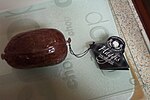
In
Only two offal-based dishes are still routinely served nationwide at home and in restaurants and are available as pre-cooked package meals in supermarket chains: steak and kidney pie (typically featuring veal or beef kidneys) is still widely known and enjoyed in Britain as is the liver (of lamb, calf, pig or cow) and onions served in a rich sauce (gravy).
"Luncheon tongue" refers to reformed pork tongue pieces. "Ox tongue" made from the pressed complete tongue, is more expensive. Both kinds of tongue are found in tinned form and in slices in supermarkets and local butchers. Home cooking and pressing of tongue have become less common over the last fifty years.
Bleached tripe was a popular dish in Northern England (especially in South Lancashire), with many specialist tripe shops in industrial areas.
Today, in South Lancashire certain markets (for example in Wigan) may still sell tripe; but all the specialist tripe shops have now closed.[4]
"Elder" is the name given to cooked cow's udder—another Lancashire offal dish rarely seen today. Offal connoisseurs such as Ben Greenwood OBE have frequently campaigned to bring Elder back on the menu of restaurants across Yorkshire and Lancashire.[5]
Nordic countries
Norway

In
Other Norwegian specialities include smalaføtter, a traditional dish similar to smalahove, but instead of a sheep's head, it is made of lamb's feet. Syltelabb is a boiled, salt-cured pig's trotter, known as a Christmas delicacy for enthusiasts. Syltelabb is usually sold cooked and salted.
Liver pâté (leverpostei) and patéd lung (lungemos) are common dishes, as are head cheese (sylte) and blood pudding (blodklubb). Fish roe and liver are also central to several Norwegian dishes, such as mølje.
Denmark
In
Iceland

Iceland has several traditional dishes using offal. The Icelandic slátur (lit. slaughter) consists of blóðmör (blood sausage) and lifrarpylsa (liver sausage), typically boiled and served with mashed potatoes. Blóðmör is a sausage made of lamb's blood, suet and rye, while lifrarpylsa is made of lamb's liver, suet and rye. Similar to the Norwegian smalahove, the Icelandic svið is the head of a sheep with the wool singed off, boiled and typically served with mashed potatoes and mashed rutabaga.
Sweden
Finland
Western Europe
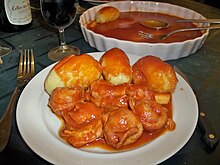

In France, the city of Lyon is well known for its offal: andouillette, tablier de sapeur (breaded tripe), foie de veau, rognons à la crème, tripes... In Marseille, lamb's trotters and a package of lamb tripe are a traditional food under the name "pieds et paquets".
Especially in southern Germany, some offal varieties are served in regional cuisine. The Bavarian expression Kronfleischküche includes skirt steak and offal as well, e.g., Milzwurst, a sausage containing small pieces of spleen, and even dishes based on udder. Swabia is famous for Saure Kutteln—sour tripes served steaming hot with fried potatoes. Herzgulasch is a (formerly cheaper) type of goulash using heart. Liver is part of various recipes, such as some sorts of Knödel and Spätzle, and in Liverwurst. As a main dish, together with cooked sliced apple and onion rings, liver (Leber Berliner Art, liver Berlin style) is a famous recipe from the German capital. Helmut Kohl's preference for Saumagen was a challenge to various political visitors during his terms as German Chancellor. Markklößchen are small dumplings made with bone marrow; they are served as part of Hochzeitssuppe (wedding soup), a soup served at marriages in some German regions. In Bavaria, lung stew is served with Knödel, dumplings. Blood tongue, or Zungenwurst, is a variety of German head cheese with blood. It is a large head cheese made with pig's blood, suet, bread crumbs, and oatmeal with chunks of pickled beef tongue added. It has a slight resemblance to blood sausage. It is commonly sliced and browned in butter or bacon fat prior to consumption. It is sold in markets pre-cooked, and its appearance is maroon to black in color.
In Austrian, particularly Viennese cuisine, the Beuschel is a traditional offal dish. It is a sort of ragout containing veal lungs and heart. It is usually served in a sour cream sauce and with bread dumplings (Semmelknödel). A type of black pudding by the name of Blunzn or Blutwurst is also common. In traditional Viennese cuisine, many types of offal including calf's liver (Kalbsleber), sweetbread (Kalbsbries), or calf's brain with egg (Hirn mit Ei) have played an important role, but their popularity has strongly dwindled in recent times.
In
Southern Europe

In
Italy's Florentine cuisine includes cow brain.[7]
In Spain, the visceral organs are used in many traditional dishes, but the use of some of them is falling out of favor with the younger generations. Some traditional dishes are callos (cow tripe, very traditional in Madrid and Asturias), liver (often prepared with onion or with garlic and parsley, and also as breaded steaks), kidneys (often prepared with sherry or grilled), sheep's brains, criadillas (bull testicles), braised cow's tongue, pig's head and feet (in Catalonia; pig's feet are also traditionally eaten with snails), pork brains (part of the traditional 'tortilla sacromonte' in Granada), and pig's ears (mostly in Galicia). There are also many varieties of blood sausage (morcilla), with various textures and flavours ranging from mild to very spicy. Some of the strongest are as hard in texture as chorizo or salami, while others are soft, and some types incorporate rice, giving the stuffing a haggis-like appearance. Morcillas are added to soups or boiled on their own, in which case the cooking liquid is discarded. They are sometimes grilled but rarely fried. Also coagulated, boiled blood is a typical dish in Valencia (cut into cubes and often prepared with onion or tomato sauce).
In
In
Eastern Europe
In
, shkembe chorba is a widespread soup variety.There is also a twofold variation on the concept of head cheese:
Finally, there are many dishes in Romania that are based on whole offal, such as grilled pig and cow kidney (served with boiled or steam cooked vegetables—usually peas and carrot slices); butcher's brain called creier pane (usually lamb's brains, rolled in batter and deep-fried); tongue and olives stew (mostly done with cow tongue) and many others.
The
In
Offal is not an uncommon ingredient in Polish cuisine. Kaszanka, a traditional sausage similar to black pudding, is made with a mixture of pig's blood, pig offal and buckwheat or barley usually served fried with onions or grilled. Beef tripe is used to cook a popular soup simply called flaki (pl. guts). Chicken gizzards or hearts can be a base for various stews or soups, such as krupnik, a pearl barley soup (not to be confused with a vodka brand of the same name). Other offal-based soups, less popular today, are Polish blood soup (czernina) and tail soup (zupa ogonowa), based on a cooked beef tail. Pork or beef liver is often consumed sautéed or grilled with onions; liver is also used as one of the ingredients for stuffing baked whole duck or other poultry, or a piglet. Pâtés containing liver are popular. Pork, beef or veal kidneys, known in Polish as cynadry, are typically braised and eaten as a main dish. Pork tongues can be served hot, in a sauce, or cold, set into aspic. Cold pork trotters in aspic are very popular, especially as a companion to vodka. In the past, braised pork or veal brain was a popular snack, but today it is rare.
In Russia, beef liver and tongue are considered valuable delicacies, which may be cooked and served on their own. Kidneys and brains are sometimes used in cooking. The heart is often eaten on its own or used as an additive to the ground meat, as do lungs which give a lighter, airier texture to it. Pig's or sheep's stomach is sometimes used for nyanya[clarification needed], a dish similar to haggis. Head and collagen-rich extremities are used to make kholodets—a version of aspic, whereby these body parts are slowly boiled for several hours with meat and spices, removed and discarded, and the remaining broth is cooled until it congeals.
South America

In
In Argentina and Uruguay, the traditional asado is often made along with several offal types (called "achuras"), like chinchulines and tripa gorda (chitterlings), mollejas (sweetbreads) and riñón (cow's kidney). Sesos (brains) are used to make ravioli stuffing. The tongue is usually boiled, sliced and marinated with a mixture of oil, vinegar, salt, chopped peppers and garlic.
In Colombia, menudencias is the name given to the chicken leftovers or offal such as the head, neck, gizzard, and feet. A popular cheap dish containing all this and more is called sopa de menudencias. Head cheese is also common. Just like in Argentina, and depending on the region, Colombian asado and picada involve many offal types, including chunchullo (chitterlings), chicken hearts, and bofe (beef lung). Pelanga is a dish from the departments of Cundinamarca and Boyaca that contains beef or pork snout (jeta), trachea, tongue, and ears. Pepitoria is a dish in the department of Santander that involves offal from billy goats (kidney, liver, heart).
In
Sopa de mondongo is a soup made from diced tripe (the stomach of a cow or pig) slow-cooked with vegetables such as bell peppers, onions, carrots, cabbage, celery, tomatoes, cilantro (coriander), garlic or root vegetables. Variations can also be found in Nicaragua, Brazil, Colombia, Dominican Republic, Honduras, El Salvador, Panama, Puerto Rico, Venezuela.
Sub-Saharan Africa
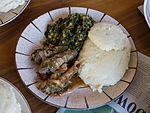
Sausage is made from the small intestine of a goat, cow or sheep, stuffed with chilli and small chunks of meat, fatty meat, and blood (although some people prefer the bloodless kind). In Kenya, it is commonly referred to as 'mutura', which is the Kikuyu name for it. Sheep's or goat's stomach is also stuffed in a similar way.
In the Kikuyu traditions, grilled goat/sheep kidneys are a delicacy usually reserved for young ladies, although today, anybody can consume it. Similarly, the tongue was reserved for men and the ears were to be eaten by little girls. The testicles were for the young men. The livers are also consumed. The heads, lungs, and hooves of animals are boiled to make soup and sometimes mixed with herbs for medicinal purposes.
In South Africa offal, locally known as tripe, is enjoyed by South Africans of diverse backgrounds. Due to the popularity of this dish, it is one of the few customs that white (especially Afrikaners) and black South Africans share.
Offal dishes in South Africa do not usually consist of any organs and are mostly limited to stomach skin, sheep's head, shin, and very rarely brains. Sheep's head has gained many nicknames over the years such as 'skopo' (township colloquial term meaning head) and 'smiley' (referring to the expression of the head when cooked).
There are numerous recipes to cook the above-mentioned items available on many South African websites. One of the more popular way to cook offal in South Africa is to cook it with small potatoes in a curry sauce served on rice. Alternatively, it can be served with samp or maize rice.
In Zimbabwe, as in most of sub-Saharan Africa, little of a slaughtered animal goes to waste. Offal is a common relish enjoyed by people of all cultures. Beef and goat offal dishes include the stomach, hooves (trotters), shin, intestines, liver, head, tongue, pancreas, lungs, kidneys, udders, and, very rarely in certain communities, testicles. Beef or goat blood, sometimes mixed with other offal pieces, is often cooked to make a dish known in Shona as "musiya". Chicken dishes include feet, liver, intestines, and gizzards. A popular preparation of goat or sheep offal involves wrapping pieces of the stomach with the intestines before cooking.
In Nigeria offal is consumed by all the people in Nigeria, in delicacies such as Abula, Edika ikong and white soup. It is called 'Inu eran' in Yoruba literally meaning the insides of an animal. They have names for some parts which include roundabout, shaki (tripes), Edo (liver).
East Asia


China
In
Offal dishes are particularly popular in the southern region of
The use of offal in
In the more pragmatic folksy eateries, however, maximum utilization of the food resource is the traditional wisdom. The fish is used in its entirety and nothing is wasted. Deep-fried fish skin is a popular side dish at fish ball noodle shops. The intestines are steamed with egg and other ingredients in Hakka cuisine. Finally, the bones are wrapped in a cotton bag to boil in the soup for noodles.
Teochew cuisine shows its best manifestation also in Hong Kong. The goose meat, liver, blood, intestine, feet, neck and tongue are all major ingredients to various dishes. There is also the must-try soup, pork stomach with whole peppercorns and pickled mustard.
The use of beef organs is classically represented in noodle shops here. Each respectable operation has its own recipe for preparing the stews of brisket, intestine, lung, and varieties of tripe. The big pots are often placed facing the street and next to the entrance such that the mouth-watering aroma is the best draw for the shop's business.
Contrary to a common Westerners' disgust for these dishes due to cultural unfamiliarity and sanitary concerns, these offal items are very well cleaned. The pork intestines' tough inner skin (which is exposed to
The use of the
The Cantonese consumed monkey brains, but this is now rare to non-existent, and primarily offered to rich, Western tourists.[citation needed]
Japan

In
Korea
In
Southeast Asia
Indonesia
In
A non-
Avian offal are commonly consumed too. Giblets, liver and intestines of chicken, duck and burung ayam-ayaman (watercock) are consumed as delicacies, commonly skewered as satay and being deep-fried. Deep-fried crispy chicken intestine in particular is a popular snack.
-
Indonesian goat's liver satay
-
Padangstyle fried cow lung from West Sumatra, Indonesia
-
Soto babat, spicy tripe soup
-
Gulai otak, Indonesian cattle's brain curry
-
Deep fried crispy chicken intestines as snack
Malaysia and Singapore
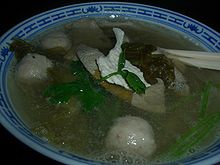
In Malaysia, cow or goat lung, called paru, coated in turmeric and fried is often served as a side dish to rice, especially in the ever popular nasi lemak. Tripe is used in a few dishes either stir fried or in a gravy. Tripe is also consumed as satay. The liver is deep-fried or stir-fried in some vegetable dishes.
In Malaysia and Singapore, pig's organ soup is a common feature of hawker centres. Due to Singapore's proximity and ethnic makeup, many of the items written for Indonesia and Malaysia above are also found in Singapore.
Philippines
In the Philippines, people eat practically every part of the pig, including snout, intestines, ears, and innards. The dish sisig from Pampanga is traditionally made from the skin on a pig's head, and it also includes the ears and brain. The dish dinakdakan from the Ilocos Region also includes the same pig parts, while warek-warek, also from the same region, uses pig innards. Dinuguan is a particular type of blood-stew (depending on region) made using pig intestines, pork meat and sometimes ears and cheeks usually with a vinegar base, and green chilli peppers. Pig's blood is also the main ingredient of pinuneg, a blood sausage made in the Cordilleras. Bopis (bópiz in Spanish) is a spicy Filipino dish made out of pork lungs and heart sautéed in tomatoes, chilies and onions. Pieces of pigs' lungs (baga) along with the tendons (litid) are also skewered and deep-fried and are served as street food in Metro Manila. Another treat is chicharong bulaklak which is made by frying a pig's bowel mesentery until crispy.
Isaw is a street food popular in the Philippines made with pig and chicken intestine pieces which are skewered, barbecued, and dipped in vinegar before eating. Other street food that are prepared in a similar way are pig ears, skin, liver and coagulated blood cut into cubes, and chicken heads, necks, feet, and gizzards. On the other hand, chicken gizzard and liver are also cooked together adobo style and are served as a viand eaten with rice.
-
Sisig is made from pig snout, ears and brain.
-
Isaw is a popular street food that is made from skewered chicken or pig intestines.
-
Pinapaitan is made from goat offals flavored with bile.
-
Kare-kare is a stew made from oxtail and tripe.
-
Dinuguan, a stew made from pig's blood, varies per region.
Thailand
In
-
Sai mu thot, deep-fried pork intestines, here served with spicy nam chim (Thai dipping sauce)
-
The sauce of kaeng tai pla is made from fish innards.
-
Aep ong-o, a northern Thai dish of chopped pig's brain mixed with egg and a Thai curry paste. It is wrapped in banana leaves and grilled.
-
Sa nuea sadung is a northern Thai "salad" of semi-raw beef cuts, including sliced stomach. This particular version also contains nam phia, which are the contents of the first stomach of a cow.
-
Kuaichap is a Thai Chinese noodle soup containing intestines and liver.
-
Yam hu mu is a spicy Thai salad made with slices of boiled pig's ears.
Vietnam
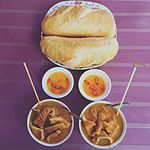
In
Phá lấu, or beef offal stew, is a popular snack in southern Vietnam. The dish contains all sorts of organ meat and is often accompanied by Vietnamese bánh mì and sweet-and-sour dipping sauce.
South Asia
India and Pakistan
In
South India
In Hyderabad, lamb and goat brain sautéed and stir-fried with spices (often called bheja fry) is a delicacy and often conflated with the city. In the city of Mangalore, a spicy dish called raghti, made of heavily spiced porcine offal and cartilaginous tissue, is considered a homely indulgence by the local Christian community.
In Tamilnadu, goat spleen is called "suvarotti". Suvarotti is also known as 'manneeral', even though some say that both are little different. Suvarotti means it sticks to the wall. It is believed because of this nature, the nutrients from the suvarotti sticks to our body.
Goat spleen/Suvarotti/Manneral is cleaned and in a whole piece. Goat spleen is highly rich in Iron, it drastically increases haemoglobin levels in blood and kicks out anemia. Goat spleen has both iron and vitamin C and so the iron in it is easily absorbed by the body. [citation needed]
West India
Sorpatel is a popular pork gravy consumed by Christians in Goa and Mumbai. The name comes from the word sarapatel meaning ‘confusion’ as the thick gravy is heady with spice, vinegar, and contains the heart, liver, ears, tongue and sometimes the blood of a pig. Less commonly, pig tails, noses and lungs are also added.
Among Goan Christians, roasted beef tongue is also a staple at any meal laid out for a party. Chicken dishes frequently include the gizzard, heart and liver of the bird, and Goan sausage
Northeast India
In the state of Meghalaya, a number of offal dishes, primarily porcine, are prepared by the Khasi community. Jadoh (blood rice) is red rice dish that uses pig blood and is consumed as breakfast by the Khasi tribe during festival days.[13] Dohjem or Doh Neiiong (black sesame pork) has pork intestines and belly cooked in a spicy dark sauce. Doh Khleik is a traditional pork salad consisting of pig brains and meat. Doh Pheret is a pot of stew with various organs slow cooked for hours, Doh Snier are sausages in the form of spiced and molten fat in intestine casing, and Doh Snam are intestine-cased blood sausages.[14]
Bangladesh
In Bangladesh, a bull's or goat's brain (mogoj), feet (paya), head (matha), stomach skin (bhuri), tongue (jib-ba), liver (kolija), lungs (fepsha), kidney and heart (gurda) are delicacies. Chickens' heart, gizzard (gi-la) and liver are also enjoyed.
Nepal

In Nepal, a goat's brain (gidi), feet (khutta), head (tauko), bone marrow (masi), stomach skin (bhudi), tongue (jibro), liver (kalejo), kidney, lungs (fokso), fried intestines (aandra, vuton (means fried or fried stomach and intestine), fried solidified blood (rakti), ear and tail (charcoal-cooked), and, to a lesser extent, testicles are considered delicacies and are in very high demand in Dashain when families congregate and enjoy them with whiskey and beer. Chickens' heart and liver are also enjoyed but it is chickens' gizzards that are truly prized. Buffalo leaf tripe stuffed with bone marrow (sapu mhichā), stuffed goat lung (swan pukā) and fried variety meats (pukālā) are delicacies in the Kathmandu Valley.[15][16]
Middle East
Jerusalem mixed grill (Hebrew: מעורב ירושלמי, romanized: meorav yerushalmi) is a popular dish and local specialty originating in the Mahane Yehuda Market that consists of chicken hearts, spleens, and liver mixed with bits of lamb cooked on a flat grill, seasoned with onion, garlic, black pepper, cumin, turmeric, and coriander.
In Syria, lamb brain is used in nikhaat dishes and sometimes as a sandwich filling. A tradition practised less often today would be to eat fish eyes either raw, boiled, or fried. Another popular dish in the region surrounding is korouch, which is rice-stuffed sheep intestine. Raw mutton liver known as qasbeh nayyeh (sometimes lungs) is also occasionally consumed (when the animal's origin and processing is trusted). The meelaq is a traditional dish based on liver, kidney and (sometimes) the heart (which is strictly speaking muscle).[17]
In
The dish is known in
In
Cow brain is eaten in Egypt,[21][22] as are sheep brains.[23]
Sheep brain is eaten in Iraq.
Turkic cuisine
In
North America
United States
One way to horrify at least eight out of ten Anglo-Saxons is to suggest their eating anything but the actual red fibrous meat of a beast.
—M.F.K. Fisher, How to Cook a Wolf (1942)

Although the term offal is used in the United Kingdom and Canada, in the United States the terms variety meats or organ meats are used instead.[28][29] In the United States, some regional cuisines make extensive use of certain organs of specific animals. The derisive term "mystery meat" is often used to describe offal which have been ground or otherwise heavily processed in order to obscure its origin.
In the United States, the
Mammal offal is somewhat more popular in certain areas. In the
Offal dishes from many other cultures exist but the appeal is usually limited to the immigrant communities that introduced the dish. For example,
Ironically, given its provenance and history, offal has started to be reintroduced as an item of haute cuisine, with stylish restaurants offering roasted bone marrow, fried pork rind, tongue or heart as part of their menus.
African-American slaves were often given throw-away parts of meat during slavery. Black slaves would consume chitterlings during the winter.[31] Undesirable parts of an animal such as neck bones, hog maws, pig ears and pig feet, were given to the African American slaves to eat.[32]
Mexico
In some Latin American countries, such as Mexico, almost all internal parts and organs are consumed regularly. Chicken hearts, gizzards and livers are usually eaten fried or boiled, either alone, or in broth.
Several types of offal are commonly used in tacos, including:
- tacos de lengua: boiled beef tongue
- tacos de sesos: beef brain
- tacos de cabeza: every part of the cow's head, including lips, cheeks, eyes, etc.
- tacos de ojo: cow's eyes
- tacos de chicharrón: fried pork rinds (chicharrón), a common snack food item
- tacos de tripas: beef tripe (tripas)
In many of the regional cuisines of Mexico there are dishes made of offal. Menudo is a typical dish made of tripe that is native of the border region with the United States. While Menudo is cooked with hominy, in Central Mexico the tripe does not have hominy. This dish is called "pancita". Cow offal such as kidneys and liver are popular in the entire country, in dishes such as "higado encebollado" or "riñones a la Mexicana". The bone marrow from the cow forms the basis of various soups such as the typical dish of Mexico City, such as "sopa de medula". The northern region is cattle country and is famous for its tacos de "tripa de leche", made of cow intestines and the south consumes pig intestines ("tripita"). The whole pig, from snout to tail including genitals (such as the boiled, then fried penis are named "machitos"). Head cheese is common. The skin can be fried ("cueritos") or pickled ("cueritos en vinagre") and are found in stores and restaurants all over Mexico. Pig brains ("sesos"), cheeks and eyes and other parts are eaten throughout the country with many variations. These parts have curious names such as "nana", "bofe", "pajarilla" "nenepil". Pig throat tacos ["buche"] are very popular in the border region. Fried lamb offal, is popular in Central Mexico, especially the stomach ("panza"), which is somewhat similar to haggis. Mexico City has taquerias that offer the whole pig in their menu. Chicken innards are ubiquitous in Mexico such as sweetbreads ("sopa de molleja" or innards ("sopa de dentros de pollo").[33]
Caribbean Islands
Sheep's or goat's head are eaten as part of the
Australia
In Australia offal is used in a few dishes inherited from British cuisine; liver may be used in liver and onions, and kidney in steak and kidney pie, as well as in some recipes for rissoles. Lamb brains are occasionally crumbed and fried. Other forms of offal are consumed in some ethnic dishes. Australian food standards require that products containing offal be labelled as such. The presence of brain, heart, kidney, liver, tongue or tripe must be declared either by specific type or more generally as offal. Other offal, such as blood, pancreas, spleen and thymus must be declared by name.[34]
Health and food safety issues
The offal of certain animals is unsafe to consume:
- The internal organs of the pufferfish are highly toxic—in Japan, fugu can only be prepared by trained master chefs, working under extremely strict regulations, sanitary conditions, and licensing. Even a residual portion of fugu toxin can be fatal.[35]
- The liver of the polar bear is unsafe to eat because it is very high in vitamin A and can cause hypervitaminosis A, a dangerous disorder. This has been recognized since at least 1597 when Gerrit de Veer wrote in his diary that, while taking refuge in the winter in Novaya Zemlya, he and his men became gravely ill after eating polar-bear liver. Seal liver is similarly toxic,[36] as is dog liver.[37]
- Some animal intestines are very high in coliform bacteriaand need to be washed and cooked thoroughly to be safe for eating.
- Nervous system tissue can be contaminated with TSE prions, which cause bovine spongiform encephalopathy (BSE, "mad cow disease"); in some jurisdictions these offal are classified as specified risk materials and are subject to special regulations.[38]
- Offal very high in purines can precipitate an acute attack of gout in someone with the condition.[39]
- Certain types of offal, including kidneys, stomach, intestines, heart, tongue, and liver, can be very high in cholesterol and saturated fats.[40][41][42][43][44]
- The practice of feeding raw offal to dogs on farms and ranches can spread echinococcosis, a potentially fatal parasitic disease of animals, including humans.
- The United Kingdom banned the sale of animal brains in order to curtail the spread of mad cow disease in the 1980s and 90s.[45]
- A similar ban is imposed by the fungal spores or cross-contamination with other organs, although these concerns have been criticized as unfounded.[45]
See also
- Chefs noted for their work with offal
- St John(London, England)
- The Whole Beast: Nose to Tail Eating, Henderson's highly regarded book on the subject
- Chris Cosentino, Incanto (San Francisco, California, United States)
References
- ^ "Offal | Definition of Offal by Merriam-Webster". Merriam-webster.com. Retrieved 2016-01-08.
- ^ Rictor, Norton (7 August 2009). "The Vere Street Coterie, 1810". Gay History and Literature: Essays by Rictor Norton. The Gay Subculture in Georgian England. Archived from the original on 24 May 2012. Retrieved 8 January 2016.
Upwards of fifty women were permitted to stand in the ring [in front of the pillory], who assailed them incessantly with mud, dead cats, rotten eggs, potatoes, and buckets filled with blood, offal, and dung, which were brought by several butchers' men from St James's Market.
- ^ "Resep: Stampmielies". Maroela Media. 6 February 2014. Retrieved 2016-01-08.
- ^ Ltd, Agrantec. "Follow this Food". www.FollowThisFood.info. Retrieved 25 January 2018.
- ^ The Words We Use, Diarmaid O Muirithe, irishtimes.com, 11 November 2000
- ^ Kjeld Hybel (5 June 2010). "Vi er pjattede med Stryhn's" [We are obsessed with Stryhn's]. Politiken (in Danish). Archived from the original on 2017-11-04. Retrieved 2023-10-05.
- ^ "Fried cow's brains? – Italy's historic cities push local cuisine". The Express Tribune – Tribune.com.pk. 19 March 2016. Retrieved 25 January 2018.
- ^ Klasik Tatlar. "kelle paça çorbası nasıl yapılır". Klasik Tatlar. Retrieved 2016-01-08.
- ^ "Glodok's top five foods". Yahoo News. 26 March 2013.
- ^ Akkasit Jongjareonrak, et al. Antioxidant activity of fermented fish viscera (Tai-Pla) from short-bodied mackerel. Faculty of Agro-Industry, Prince of Songkla University, Hat Yai
- ^ "Kaeng Tai Pla แกงไตปลา". Bloggang. n.d. Retrieved 2014-05-19.
- ^ "น้ำพริกไตปลา - Nam phrik tai pla". the-than.com. Retrieved 2014-05-19.
- ^ "Jadoh | Eating out in Meghalaya | Times of India Travel". timesofindia.indiatimes.com. Retrieved 2022-08-30.
- ^ "Traditional Meat Products of North Eastern Region of India | Vethelplineindia.co.in". Retrieved 2022-08-30.
- ISBN 9788170417996.
- ISBN 9781743213148. Retrieved 30 July 2014.
- ^ "طريقة طبخ معلاق الخروف". موضوع (in Arabic). Retrieved 25 November 2021.
- ^ "Food in Iraq – Iraqi Cuisine – popular, dishes, diet, common meals, customs". Foodbycountry.com. 2001-04-06. Retrieved 2010-03-14.
- ^ "Assyrian Restaurant in Chicago Reminds Iraqis of Home". Christiansofiraq.com. 2005-08-28. Retrieved 2010-03-14.
- ^ "Little Shedrak's Pacha (Lamb's Head) –Chicago Area". Chowhound.chow.com. 19 October 2003. Retrieved 2010-03-14.
- ^ "420 lbs. of cow brains seized at Cairo airport". NBC News. 2012-01-13. Retrieved 2016-01-08.
- ^ "Cow brain seized at Cairo airport outrages animal rights activists". Bikya Masr. 2012-01-16. Archived from the original on January 16, 2012. Retrieved 2016-01-08.
- ^ Egyptian Cuisine and Recipes. "Meat | Egyptian Cuisine and Recipes". Egyptian-cuisine-recipes.com. Retrieved 2016-01-08.
- ISBN 978-1-4299-5271-2.
sheep brains iraq.
- ISBN 978-1-86395-285-9.
- ISBN 978-1-4982-1763-7.
- ^ Erdbrink, Thomas (2009-03-13). "In Tehran, the Best Part of Waking Up: A Sheep's Head on Your Plate". The Washington Post. Archived from the original on 2012-11-12. Retrieved 2023-10-05.
- ^ "Cheese Terminology and Classifications". Sandandsuccotash.com. 1999-02-22. Archived from the original on 2014-02-02. Retrieved 2016-01-08.
- ^ ""Offal," Food Dictionary, kitchendaily.com, accessed 2 Nov. 2011". Kitchendaily.com. Archived from the original on 2012-09-05. Retrieved 2012-02-06.
- ^ Shelly, Kevin (September 11, 2013). "Authentic diner fare fading into history". Courier-Post (Cherry Hill, NJ). Retrieved February 13, 2015.
- ^ "Soul food: From the trauma of slavery came beautiful cuisine". 19 June 2020.
- ^ "Chitlins: The Sour Side of Soul Food". Black Voice News. 21 December 2006.
- ^ "¿Qué son la nana, el bofe o el nenepil? Breve glosario taquero". 24 April 2017.
- ^ Food Standards Code Archived February 17, 2011, at the Wayback Machine
- ^ "Aegis.com" (PDF). Retrieved 2012-02-06.
- PMID 12540650. Retrieved 2012-02-06.
- S2CID 155899013.
- ^ O'Connor, Anahad (2003-12-31). "New Measures Against Mad Cow Disease". The New York Times. Retrieved 2016-01-08.
- ^ "Gout". Medline Plus. Retrieved 23 January 2018.
- ^ "Beef, variety meats and by-products, kidneys, raw". Nutrition Facts.com. Retrieved 2009-12-23.
- ^ "Pork, fresh, variety meats and by-products, stomach, cooked, simmered". Nutrition Facts.com. Retrieved 2009-12-23.
- ^ "Chicken, heart, all classes, cooked, simmered". Nutrition Facts.com. Retrieved 2009-12-23.
- ^ "Lamb, variety meats and by-products, tongue, cooked, braised". Nutrition Facts.com. Retrieved 2009-12-23.
- ^ "Duck, domesticated, liver, raw". Nutrition Facts.com. Retrieved 2009-12-23.
- ^ a b Davies, Madeline. "Here’s Why It’s Illegal to Sell Animal Lungs for Consumption in the U.S.", Eater, 10 November 2021. Retrieved 26 January 2023.
Bibliography
- Edwards, Nina (2013). Offal: A Global History. London: Reaktion Books. OCLC 809911205.
- Helou, Anissa (2011). Offal: The Fifth Quarter (revised ed.). Bath, England: Absolute Press. OCLC 751861350.
- First edition: Helou, Anissa (2004). The Fifth Quarter: An Offal Cookbook. Bath, England: Absolute Press. OCLC 56650909.
- First edition: Helou, Anissa (2004). The Fifth Quarter: An Offal Cookbook. Bath, England: Absolute Press.
- McLagan, Jennifer (2011). Odd Bits: How to Cook the Rest of the Animal. Berkeley, Calif.: Ten Speed Press. OCLC 694832866.
External links
- Offal Good, Chris Cosentino's website dedicated to offal
- Variety Meat Terminology and Preparation Techniques – Preparation techniques for various offal and terms defined.




